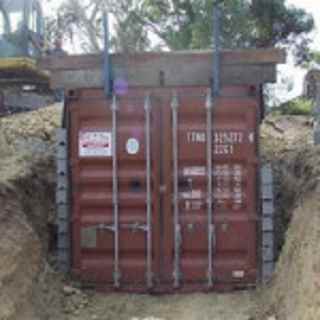What Every Prepper Should Know About Shipping Containers
When it comes to prepping, many folks are interested in using shipping containers for a secondary retreat or bug out shelter. However, there are a lot of misconceptions and mislead ideas with regards of how to move them, use them, and maintain them – and we’ve heard most of the questions several times over. The good thing is, with a few exceptions, the questions are all similar. What this tells me is that there’s a consistent path of logic that I can follow, but there’s a little information that the people asking the question haven’t been introduced to. To no fault of their own, it’s really only something that you’d consider if you a) deal with shipping containers on a daily basis, or b) have the same question asked enough times that you do the research yourself. The main areas of missing information are around moving/transporting shipping containers to their site, setting up foundations/burying/covering containers, and retrofitting the unit for proper use.
RELATED : Bug-Out Backup: How to Find Shelter Undergound
*For those of you that don’t know what “prepping” is, Prepper Resources describes a prepper as “A thoughtful, determined, self reliant and perceptive person who takes out a tangible insurance policy in order to mitigate the risks which are presented by an often unstable and unpredictable society. This insurance policy involves stockpiling supplies (food, water, medical, personal protection) as well as learning new skills in order to become more self reliant. A prepper’s insurance policy could be compared to auto, medical or life insurance in that when something unpredictable happens (e.g. natural disaster or global food/resource shortages) the prepper is prepared to weather the storm.
RELATED : Bug-out (Evacuation) Plan – Ideas For Your Bug-out Task List
A shorter definition from The Daily Prep: Prepping is the practice of acquiring skills and supplies that can be used to mitigate emergency situations….or in plain english, creating fallback plans for when the shit hits the fan!
Moving Shipping Containers: Mislead Idea #1
Idea: I’d like the container moved to my property (location A), then I’ll gradually load it, then I’d like you to come back three months later and move it to my “alternate location” (location B).
Problem: Sure, the shipping container can be moved to location A with no problems. We run into the problem when the trucking company returns to pick the unit up. You’ll need a fork lift or crane on site that can pick it up and put it on the chassis or flatbed, and most people don’t have this type of equipment on site. At this point the project needs to be revised around this obstacle.
Moving Shipping Containers: Mislead Idea #2
Idea: I’m in the planning phase and need two 40′ containers delivered to my vacant lot in the mountains. I’d like them placed in a hole (which may or may not be dug out yet), and I don’t have a fork lift or crane on site.
Problem: A truck driver with a roll off truck doesn’t need a fork lift, but no matter how skilled he is he can’t drop a container of any size in a hole; and for that matter neither can a fork lift. We’re happy to sell you any number of containers, but would also like to see your project be successful. If this is your goal it’s best to have your holes cleared out, contact a local crane operator that’s cost effective enough to be affordable, but large enough to get the job done properly, and have the containers delivered on the same day on a flatbed truck or chassis (which tends to have a cheaper per mile cost than a roll off).
RELATED : Real Life Perspective: How To Survive When Danger Is Right Outside Of Your Front Door
Burying Shipping Containers: Mislead Idea #1
Idea: I’d like to bury my shipping container shelter so that no one can see it.
Problem: On the surface, it’s a great idea and I’d like to do it myself. The sides of shipping containers aren’t designed to hold or support weight for an extended period of time. You’ll need to investigate a way to keep the pressure off the walls of the container. For an idea, read this article on using Gabion baskets to bury a shipping container.
RELATED : EMP Effects on Vehicles
Burying Shipping Containers: Mislead Idea # 2
Idea: I’d like to bury my container shelter completely, and have a few feet of soil on top of the unit.
Problem: Just as the walls of a shipping container aren’t designed to hold weight, neither is the roof. Shipping containers are designed to carry their weight in the corner posts, which makes stacking them easier. Think of it like this: Take a piece of plywood and stack two bricks on top of each other under each of the four corners. If you stand in the middle what happens? The result is cracked plywood. The roof of a container will do the same thing given enough time and pressure. If you are fixed on doing this you’ll need to find a way to truss out the top of the unit and keep some of the pressure off the roof, or just not bury it as deep.
RELATED : Doomsday Apocalypse Shelter and Bunkers
Retrofitting a Shipping Container: Mislead Idea #1
Idea: I’m going to buy a container, then stop over at home depot and buy a door and a couple of windows to put in it.
Problem: This can be done, but standard window and door frames aren’t designed for this use, and will require a fair amount of effort to make it work. Containers tend to flex a little, so the frames need to be sensitive to this, as does the seal of the window and the door locks. There are a few suppliers of doors and windows that are specifically designed for shipping containers. Drop us an email and we’ll send you the details (the one we use the most doesn’t have a website yet).
Conclusions
Using containers for a fallback or bug out shelter is a great idea, and done more frequently all the time. As with any project, a strong shipping container shelter takes planning and dedication; and the end product is very rewarding and secure. If you have any questions about buying, moving, or using shipping containers as survival shelters feel free to ask us.
*While most questions are grounded in honest reality, the most concerning one that our staff and industry colleagues couldn’t answer (or wouldn’t – for legal reasons), was “I have a family of four, and a dog. If something happens and my family and I are sealed into a container with supplies, how long can we survive on the air in a 20′ vs. 40′ container?”
RELATED : Ark Two Underground Bunker: largest Private Doomsday Shelter on Earth
By Ryan @ ContainerAuction.com
ContainerAuction, Inc was founded in 2010 and is working to become a global leader in the sale of new and used shipping containers. We specialize in helping sellers of all sizes market their shipping containers and related equipment. Our management team and advisory board consists of industry professionals with years of experience in container finance, trading, and fleet management. (source)
Survive Attack to Our Power Grid System (Weapon That Can Instantly End Modern Life in America)
Survival MD (Best Post Collapse First Aid Survival Guide Ever)
Backyard Innovator (A Self Sustaining Source Of Fresh Meat,Vegetables And Clean Drinking Water)
Blackout USA (EMP survival and preparedness)
Conquering the coming collapse (Financial advice and preparedness )
Liberty Generator (Build and make your own energy source)
Backyard Liberty (Easy and cheap DIY Aquaponic system to grow your organic and living food bank)
Bullet Proof Home (A Prepper’s Guide in Safeguarding a Home )
Family Self Defense (Best Self Defense Strategies For You And Your Family)
Survive Any Crisis (Best Items To Hoard For A Long Term Crisis)
Survive The End Days (Biggest Cover Up Of Our President)
Drought USA(Discover The Amazing Device That Turns Air Into Water)




Something I missed in reading this, or was not mentioned about sea containers, is they have a wood floor that if you do not place on stones or at least allow air flow underneath will rot the wooden floor, this happens quite fast above ground here in Louisiana, probably faster in a hole.